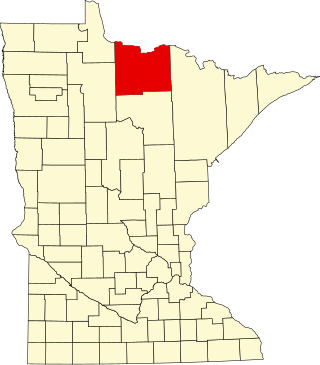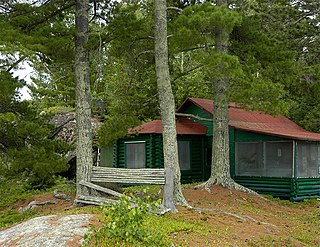
This is a list of sites in Minnesota which are included in the National Register of Historic Places. There are more than 1,700 properties and historic districts listed on the NRHP; each of Minnesota's 87 counties has at least 2 listings. Twenty-two sites are also National Historic Landmarks.

This is a list of the National Register of Historic Places listings in Saint Louis County, Minnesota. It is intended to be a complete list of the properties and districts on the National Register of Historic Places in Saint Louis County, Minnesota, United States. The locations of National Register properties and districts for which the latitude and longitude coordinates are included below, may be seen in an online map.

This is a list of the National Register of Historic Places listings in Washington County, Minnesota. It is intended to be a complete list of the properties and districts on the National Register of Historic Places in Washington County, Minnesota, United States. The locations of National Register properties and districts for which the latitude and longitude coordinates are included below, may be seen in an online map.

This is a list of the National Register of Historic Places listings in Cass County, Minnesota. It is intended to be a complete list of the properties and districts on the National Register of Historic Places in Cass County, Minnesota, United States. The locations of National Register properties and districts for which the latitude and longitude coordinates are included below, may be seen in an online map.

This is a list of the National Register of Historic Places listings in Koochiching County, Minnesota. It is intended to be a complete list of the properties and districts on the National Register of Historic Places in Koochiching County, Minnesota, United States. The locations of National Register properties and districts for which the latitude and longitude coordinates are included below, may be seen in an online map.

The Duluth Civic Center Historic District is a historic government complex in Duluth, Minnesota, United States. It includes the St. Louis County Courthouse, Duluth City Hall, and the Gerald W. Heaney Federal Building. The complex was designed by urban planning pioneer Daniel Burnham in 1909 and constructed over the next twenty years. It was listed as a historic district on the National Register of Historic Places in 1986 for its state-level significance in the themes of architecture and community planning and development. It was nominated for its associations with Burnham and the City Beautiful movement.

This is a list of the National Register of Historic Places listings in Becker County, Minnesota. It is intended to be a complete list of the properties and districts on the National Register of Historic Places in Becker County, Minnesota, United States. The locations of National Register properties and districts for which the latitude and longitude coordinates are included below may be seen in an online map.

This is a list of the National Register of Historic Places listings in Meeker County, Minnesota.

The Kettle Falls Hotel is a historic hotel in what is now Voyageurs National Park in the U.S. state of Minnesota. It opened in 1913 deep in the wilderness of the Boundary Waters, at the juncture of Namakan and Rainy Lakes. Today it is the only lodging operating inside the park, and remains accessible only by water.
This is a list of the National Register of Historic Places listings in Voyageurs National Park.

The Kettle Falls Historic District encompasses a remote pocket of early-20th-century industrial and commercial activity deep in the Boundary Waters, in what is now Voyageurs National Park in the U.S. state of Minnesota. Kettle Falls is the outlet from Namakan Lake into Rainy Lake on the Canada–United States border. The portage between the two lakes served as a key gathering point from the time of the voyageurs to the miners, commercial fishermen, and lumbermen at the turn of the 20th century, and tourists beginning in the 1930s. The Kettle Falls Dam was built at the site between 1910 and 1914, and two log buildings associated with its construction remain standing. The fourth contributing property to the historic district is the Kettle Falls Hotel, built in 1913.

The Jun Fujita Cabin is a historic summer cabin in the U.S. state of Minnesota, owned by photographer and poet Jun Fujita (1888–1963). He built it in 1928 on an island in Rainy Lake, an area of the Boundary Waters that later became Voyageurs National Park. The cabin was listed on the National Register of Historic Places in 1996 for its local significance in the themes of art, Asian ethnic heritage, and entertainment/recreation. It was nominated for its association with Fujita, one of the first Japanese Americans to gain prominence in the American Midwest, and as a rare surviving example of the early recreational development of the Boundary Waters.

The historic Duluth Public Library is a former Carnegie library building at 101 West Second Street in Duluth, Minnesota, United States. It was constructed in 1902 as the first purpose-built facility of the Duluth Public Library. It was listed on the National Register of Historic Places in 1978 for its local significance in the themes of architecture and education. It was nominated for its Neoclassical architecture and association with early community education efforts.

The Johannes Erickson House is a historic log cabin in Scandia, Minnesota, United States, built in 1868 with a gambrel roof, a distinctive tradition from southern Sweden. It was moved to its current site adjacent to the Hay Lake School in 1974 to be part of a small museum complex operated by the Washington County Historical Society. The Erickson House was listed on the National Register of Historic Places in 1976 for having local significance in the themes of architecture and exploration/settlement. It was nominated as a rare surviving example of a style brought to Minnesota by Swedish immigrants from Dalsland and Småland.

The Virginia–Rainy Lake Lumber Company Manager's Residence is a historic house in Virginia, Minnesota, United States. It was built in 1910 to provide upscale quarters for the manager of the Virginia–Rainy Lake Lumber Company, the largest lumber company in the area. The house was listed on the National Register of Historic Places in 1980 for its local significance in the themes of industry and social history. It was nominated for reflecting the social distance enforced between industry elites and laborers in the early 20th century. The city's working class population at the time was crowded into boarding houses and small cottages, and it was common for large companies to erect lavish residences for their managerial class in the belief that telegraphing class distinctions was essential for maintaining workforce discipline.

The Lester River Fish Hatchery was a federal fish hatchery in Duluth, Minnesota, United States. It was built at the mouth of the Lester River in the 1880s to propagate fish for the Lake Superior commercial fishery. The hatchery closed in 1946 and the facility was sold to the University of Minnesota Duluth, which used it as its Limnological Research Station. The surviving four buildings are noted for their Stick and Shingle Style architecture, forming a distinctive landmark to local residents as well as tourists heading to Superior's North Shore.

The Anna and Mikko Pyhala Farm is a historic farmstead in Embarrass, Minnesota, United States, now preserved as a visitor attraction. It was established by a Finnish-American family in 1909 and includes seven surviving buildings, including several constructed with traditional Finnish log architecture, and the ruins of a prior settler's log cabin dating to around 1895. The farm was listed as a historic district on the National Register of Historic Places in 2003 for its state-level significance in the themes of agriculture, architecture, and European ethnic heritage. It was nominated for being one of St. Louis County's best examples of a Finnish-American farm with log architecture, and for its association with Finnish immigration to northeast Minnesota and the conversion of its cutover forests into productive farmland.

Listening Point was the private retreat of conservationist Sigurd F. Olson (1899–1982) on Burntside Lake in Morse Township, Minnesota, United States. Olson acquired the property in 1956, then purchased a log cabin and a log sauna elsewhere that he had dismantled, moved to Listening Point, and reassembled. In 1998 the Listening Point Foundation was organized to preserve the property as an open-air museum to Olson.

The Kabetogama Ranger Station District is a historic ranger station complex in Kabetogama, Minnesota, United States. It was built from 1933 to 1941 by the Civilian Conservation Corps (CCC) as an administrative center for Kabetogama State Forest, managed by the Minnesota Department of Natural Resources. Following the establishment of Voyageurs National Park in the 1970s, the Minnesota government finalized the donation of the property to the National Park Service (NPS) in 1987. The NPS continues to use the property as one of the four administrative and visitor entrances to Voyageurs.

The William Ingersoll Estate is a former summer home complex on an island in Sand Point Lake in the U.S. state of Minnesota, in what is now Voyageurs National Park. William P. Ingersoll (1885–1973) was a wealthy philanthropist from Canton, Illinois. He purchased the island property in 1927, when the Boundary Waters region had become a wilderness vacation destination for adventurous upper-class Midwesterners. The following year he installed a mail-order cabin from the E. F. Hodgson Company of Massachusetts, which specialized in prefabricated buildings. Ingersoll usually spent four months of the year on his island and continued to develop the property until he sold it in 1962 at the age of 77. In 2011 the estate was listed on the National Register of Historic Places for its local significance in the themes of architecture and entertainment/recreation. It was nominated as an example of the area's upper-class summer homes and as a rare intact example of a E. F. Hodgson Company kit house.






















